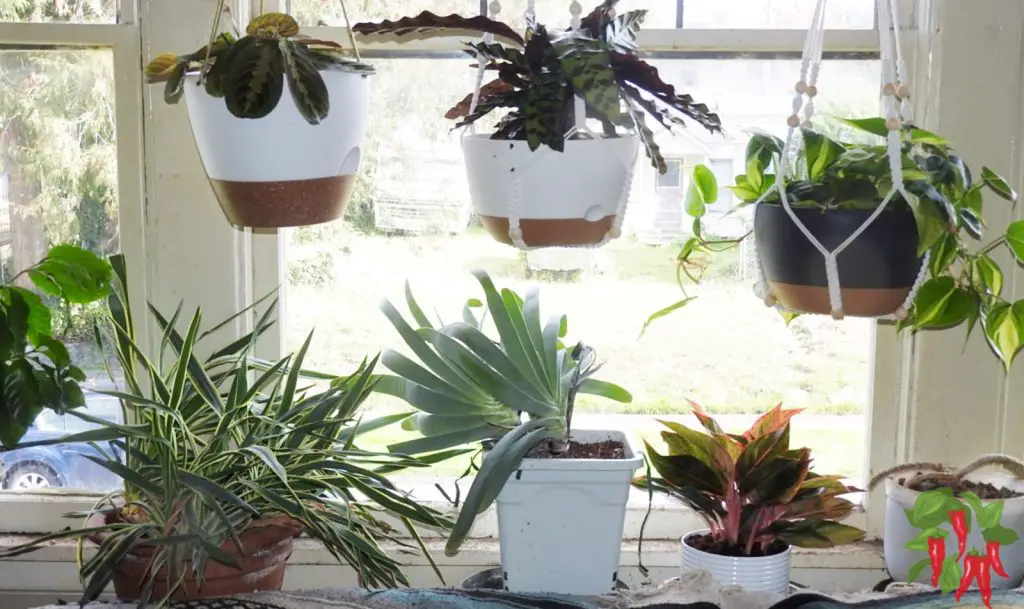This post contains affiliate links. If you buy something from one of our links we may earn a commission. Thanks

How to Identify Plants That Thrive in Indirect Sunlight
Learning how to identify plants that thrive in indirect sunlight is easier than you might think!
Feeling frustrated with plants that just won’t grow in your shadier spots? Don’t worry – there’s a whole world of beautiful, lower light loving plants out there.
Let’s discover how to find these shade superstars and transform those dim corners into lush, green oases.
Plants That Thrive in Indirect Sunlight Key Takeaways
- How to Identify Plants That Thrive in Indirect Sunlight:
- Look for plants with large, thin leaves and dark green foliage.
- Check plant labels for terms like “low light” or “shade-tolerant”.
- Consider species from tropical understories or temperate forests. Use the hand shadow test to assess light levels.
- Popular choices include pothos, peace lilies, and snake plants.
How to Identify Plants That Thrive in Indirect Sunlight
Not all plants need full sun to flourish. Many species have evolved to thrive in the dappled light of forest understories or the soft illumination of north-facing windows.
Identifying these shade-loving plants is key to creating lush, vibrant gardens in areas with indirect sunlight. Let’s explore how to spot these low-light lovers.
Understanding Indirect Sunlight
Before we dive in, let’s clarify what we mean by indirect sunlight:
• Bright indirect light: Strong daylight without direct sun rays
• Medium indirect light: Moderately bright areas away from windows
• Low indirect light: Dim areas that still receive some natural light
Characteristics of Indirect Sunlight Plants
Plants adapted to indirect light often share certain features:
1. Large, Thin Leaves:
• Maximize light absorption in low-light conditions
• Examples: Peace lily, philodendron
2. Dark Green Foliage:
• Higher chlorophyll content for efficient photosynthesis
• Examples: Cast iron plant, ZZ plant
3. Slow Growth:
• Conserve energy in low-light environments
• Examples: Snake plant, pothos
4. Variegated Leaves:
• Light patterns help brighten dim spaces
• Examples: Chinese evergreen, prayer plant
5. Natural Habitats
Many indirect light plants originate from:
• Tropical understories
• Temperate forests
• Shaded rocky areas
Common Plant Families for Indirect Light
When you’re on the hunt for plants that thrive in indirect sunlight, it helps to know which plant families are natural shade-lovers.
These families have evolved over time to flourish in the dappled light of forest floors or the soft glow of north-facing windows.
By familiarizing yourself with these plant families, you’ll have an easier time identifying potential candidates for your low-light spaces.
Let’s explore some of the most common plant families that are known for their shade tolerance:
1. Araceae (Aroid Family):
This diverse family is a goldmine for indirect light plants. Notable members include:
- Philodendrons: Known for their heart-shaped leaves
- Pothos: Popular for their trailing vines
- Peace Lilies: Prized for their elegant white flowers
- Monstera: Loved for their large, split leaves
- Many Araceae plants are excellent air purifiers

Costa Farms Monstera Swiss Cheese Plant, Easy to Grow Split Leaf Houseplant in Indoors Nursery Plant Pot, 2-3 Feet Tall
2. Marantaceae (Prayer Plant Family):
Known for their striking leaf patterns and movements. Popular genera include:
- Calathea: Features intricate leaf designs
- Maranta: The classic “prayer plant”
- Stromanthe: Often has colorful undersides to leaves
- These plants often close their leaves at night, resembling praying hand
 Lemon Lime Prayer Plant, Lemon Lime Maranta, Popular and Attractive houseplant, Gorgeous Live Indoor Plant, Easy to Care for, 4 inch Pot
Lemon Lime Prayer Plant, Lemon Lime Maranta, Popular and Attractive houseplant, Gorgeous Live Indoor Plant, Easy to Care for, 4 inch Pot
3. Asparagaceae:
A diverse family that includes many low-light tolerant species. Notable members:
- Snake Plants (Sansevieria): Extremely hardy and air-purifying
- Cast Iron Plants (Aspidistra): Nearly indestructible
- Spider Plants (Chlorophytum): Easy to grow and propagate
 Costa Farms Premium Live Indoor Snake Sansevieria Floor Plant Shipped in Décor Planter, 2-Feet Tall
Costa Farms Premium Live Indoor Snake Sansevieria Floor Plant Shipped in Décor Planter, 2-Feet Tall
4. Polypodiaceae (True Fern Family):
Ferns are classic shade-loving plants. Popular indoor varieties:
- Boston Fern (Nephrolepis)
- Bird’s Nest Fern (Asplenium)
- Maidenhair Fern (Adiantum)
- Known for their delicate, lacy foliage
 Costa Farms Bird’s Nest Fern Plant, Easy Care Live Indoor Houseplant in Modern Decor Planter, 15-Inches Tall
Costa Farms Bird’s Nest Fern Plant, Easy Care Live Indoor Houseplant in Modern Decor Planter, 15-Inches Tall
5. Dracaenaceae:
Often grouped with Asparagaceae, but worth mentioning separately. Includes popular low-light plants like:
- Dracaena: Various species with striking foliage
- Lucky Bamboo (Dracaena sanderiana): Despite its name, not a true bamboo
 Costa Farms Dracaena Golden Heart Live Indoor Plant, Easy to Grow Houseplant in Modern Plant Pot, 2-3 Feet Tall
Costa Farms Dracaena Golden Heart Live Indoor Plant, Easy to Grow Houseplant in Modern Plant Pot, 2-3 Feet Tall
6. Aglaonema (Chinese Evergreen):
• Entire genus is known for low-light tolerance
• Many varieties feature beautiful leaf variegation
• Easy to care for and adaptable to various indoor conditions
 Costa Farms Chinese Evergreen, Red, Easy to Grow Live Indoor Plant Aglaonema, 1-2 Feet Tall
Costa Farms Chinese Evergreen, Red, Easy to Grow Live Indoor Plant Aglaonema, 1-2 Feet Tall
7. Begoniaceae (Begonia Family):
• While some begonias prefer bright light, many thrive in shade
• Rex Begonias are particularly well-suited to low-light conditions
• Known for their colorful, often patterned leaves
 BubbleBlooms Begonia Rex Assortment, in 2 inch pots, Set of 3, Tiny Mini Pixie Plant Begonia Variety Pack
BubbleBlooms Begonia Rex Assortment, in 2 inch pots, Set of 3, Tiny Mini Pixie Plant Begonia Variety Pack
By focusing on these plant families, you’ll have a great starting point for selecting plants that are likely to thrive in your indirect light conditions.
Remember, while these families are generally shade-tolerant, individual species within each family may have varying light requirements.
Always check the specific care instructions for any plant you’re considering. With this knowledge, you’ll be well-equipped to create a diverse and thriving indoor garden, even in your shadiest spots!
Reading Plant Labels
Look for these terms on plant labels:
• “Low light”
• “Shade-tolerant”
• “Indirect light”
Tools for Assessing Light Levels
1. Light meters: Measure foot candles or lux
2. Smartphone apps: Like “Light Meter” or “Lux Light Meter Pro”
Popular Indirect Sunlight Plants
1. Foliage Plants:
• Pothos (Epipremnum aureum)
• Snake Plant (Sansevieria trifasciata)
• ZZ Plant (Zamioculcas zamiifolia)
2. Flowering Plants:
• Peace Lily (Spathiphyllum)
• African Violet (Saintpaulia)
• Begonia
3. Ferns:
• Boston Fern (Nephrolepis exaltata)
• Bird’s Nest Fern (Asplenium nidus)
• Maidenhair Fern (Adiantum)
The Hand Shadow Test
A simple way to assess light levels:
1. Hold your hand about 12 inches from a white surface
2. If you see a crisp shadow, it’s bright indirect light
3. A fuzzy shadow indicates medium indirect light
4. Barely visible shadow suggests low indirect light
Adapting Plants to Indirect Light
While some plants naturally thrive in low light, others can adapt:
• Gradual Acclimation: Slowly move sun-loving plants to shadier spots over weeks
• Pruning: Remove excess foliage to help plants conserve energy
• Fertilizing: Use a balanced, water-soluble fertilizer to support growth
Signs of Insufficient Light
Even shade-tolerant plants can struggle if light is too low. Watch for:
• Leggy growth: Plants stretching towards light sources
• Smaller leaves: New growth may be smaller than usual
• Slow growth or dormancy: Little to no new growth over time
• Leaf drop: Plants shedding leaves to conserve energy
Enhancing Indirect Light
If your space is particularly dim, consider these strategies:
• Reflective surfaces: Use mirrors or light-colored walls to bounce light
• Artificial lighting: Supplement with LED grow lights
• Regular cleaning: Keep windows clean to maximize natural light
• Strategic pruning: Trim outdoor plants that may be blocking light
Creating a Thriving Indirect Light Garden
Combine various shade-loving plants for a lush, layered look:
• Tall plants: Use snake plants or ZZ plants as backdrop
• Mid-height plants: Add texture with ferns or prayer plants
• Trailing plants: Let pothos or philodendrons cascade from shelves
• Accent plants: Include colorful plants like begonias or calatheas for pops of color
Identifying Plants That Thrive in Indirect Sunlight Conclusion
Identifying plants that thrive in indirect sunlight opens up a world of possibilities for shaded areas in your home or garden.
By understanding the characteristics of these shade-loving plants and assessing your light conditions, you can create lush, green spaces even in the dimmest corners.
Remember, while these plants tolerate low light, most still need some light to thrive.
Observe your plants closely and be prepared to adjust their positions if they show signs of insufficient light. With the right selection and care, your indirect light areas can become vibrant, thriving plant havens.
Key Takeaways:
• Many plants thrive in indirect sunlight, making them perfect for shaded areas
• Look for plants with large, thin leaves and dark green foliage
• Use plant labels, light meters, or the hand shadow test to assess light levels
• Popular indirect light plants include pothos, peace lilies, and ferns
• Gradually acclimate sun-loving plants to shadier spots if needed
• Watch for signs of insufficient light and adjust plant placement as necessary
• Enhance indirect light with reflective surfaces or artificial lighting
• Combine various shade-loving plants for a lush, layered garden look
Learn more: Best Indirect Sunlight Plants: A Comprehensive Guide
Happy shade gardening!
Visit my Amazon Influencer Page for videos and gardening products Grow Your Own Garden

 Hey there, plant lovers! I'm Steve, the green thumb behind
Hey there, plant lovers! I'm Steve, the green thumb behind